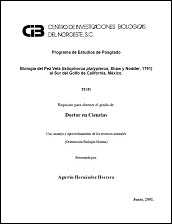Proteinaceous exotoxins of shrimp-pathogenic isolates of Vibrio penaeicida and Vibrio nigripulchritudo
Exotoxinas proteicas de cepas de Vibrio penaeicida y Vibrio nigripulchritudo, patogénicas para camarón
Autor
GABRIEL AGUIRRE GUZMAN
FELIPE DE JESUS ASCENCIO VALLE
Metadatos
Mostrar el registro completo del ítemResumen
"The pathogenicity of two V. penaeicida strains, AM101 and KH-1, with different geographic origin, and V. nigripulchritudo strain AM102, were investigated in juvenile blue shrimp species Litopenaeus stylirostris. Alive bacteria and protein fractions (PFs) obtained from cell-free supernatants (CFS) were used in experimental challenges. Strains AM102, AM101, and KH-1 produced respectively 60, 54 and 12% mortality at 96 h after infection using 104 cfu mL–1 of bacterial suspension. Exocellular toxin-like factors were evidenced in CFS from the New Caledonian strains (AM102 and AM101) but not in the Japanese strain (KH-1). At 48 h post injection of each CFS, mortality rates were respectively 96, 98 and 5% when these strains were cultivated at 20°C, whereas only 0, 16 and 5% mortality rates were observed when these strains were cultivated at 30ºC. Clear differences in pathogenicity between both V. penaeicida strains of distinct geographic origin (AM101 and KH-1) were thus emphasized. Protein fractions were obtained from CFS of all the strains tested in this study and cultivated at 20°C, by ammonium sulfate precipitation. Whatever the used strain, significantly higher mortalities were produced with PFs obtained with 0–40% of ammonium sulfate saturation, in respect to those produced with PFs60 and PFs80. Shrimp injected with PFs40 from strains AM102, AM101 and KH-1, and at a 20-μg org–1 dose produced respectively 100, 90 and 60% mortality 46 h after the challenge. The strain AM101 showed a median lethal dose of approximately 5 μg protein org–1 (1–1.25 μg protein g–1 body weight) 59 h after injection. The PFs40 from New Caledonian strains were found sensitive to heating and proteinase K treatments, reinforcing thus the hypothesis of their proteinaceous nature. Surprisingly, PFs40 from each bacterial strain displayed similar protein bands by SDS-PAGE suggesting that the tested strains share a common exotoxic compound regardless their distinct geographic origin or species." "La patogenicidad de dos cepas de V. penaeicida, AM101 y KH-1, con diferente origen geográfico, y de la cepa AM102 de V. nigripulchritudo fue investigada en camarones azules juveniles de la especie Litopenaeus stylirostris. Las bacterias vivas y las fracciones proteicas (FPs) obtenidas del sobrenadante libre de células (SLC) fueron usadas en un ensayo experimental. Las cepas AM102, AM101 y KH-1 produjeron respectivamente una mortalidad de 60, 54 y 12%, 96 h después de la infección al usar una suspensión bacteriana de 104 ufc mL–1. Factores tipo toxina exocelular fueron evidenciados en los SLC de las cepas de Nueva Caledonia (AM102 y AM101) pero no en la cepa japonesa (KH-1). A 48 h post-inyección de cada SLC, el porcentaje de mortalidad fue respectivamente de 96, 98 y 5% cuando estas cepas fueron cultivadas a 20°C, mientras que sólo 0, 16, y 5% de mortalidad fue observado cuando las cepas fueron cultivadas a 30°C. Se observó una clara diferencia en la patogenicidad entre las dos cepas de V. penaeicida provenientes de diferentes orígenes geográficos (AM101 y KH-1). Las FPs fueron obtenidas a partir del SLC de todas las cepas cultivadas a 20°C, por medio de precipitación con sulfato de amonio. Se obtuvo una mortalidad significativa con las FPs precipitadas con 40% de sulfato de amonio, en comparación con las precipitadas con 60 y 80%. Los camarones inyectados con FPs40 de AM102, AM101 y KH-1 a una dosis de 20 μg de proteína org–1 tuvieron una mortalidad de 100, 90 y 60%, respectivamente, 46 h después del ensayo. La cepa AM101 mostró una dosis letal media de aproximadamente 5 μg proteína org–1 (1–1.25 μg de proteína g–1 de peso del cuerpo), 59 h después de ser inyectada. Las FPs40 de las cepas de Nueva Caledonia fueron sensibles al tratamiento con calor y proteinasa K, reforzando la hipótesis de su naturaleza proteica. Sorpresivamente, las FPs40 de cada cepa bacteriana mostraron bandas proteicas similares cuando se analizaron por SDS-PAGE, sugiriendo que las cepas ensayadas comparten un elemento exotóxico en común, independientemente de su diferente origen geográfico."
Colecciones
Ítems relacionados
Mostrando ítems relacionados por Título, autor o materia.
-
Modulación por probióticos de la comunidad bacteriana intestinal de juveniles de Litopenaeus vannamei infectados con Vibrio parahaemolyticus CAIM 170
IRASEMA ELIZABETH LUIS VILLASEÑOR; DOMENICO VOLTOLINA LOBINA; BRUNO GOMEZ GIL RODRIGUEZ SALA; FELIPE DE JESUS ASCENCIO VALLE; ANGEL ISIDRO CAMPA CORDOVA; JUAN MANUEL AUDELO NARANJO -
Actividad antibacteriana en la hemolinfa de la almeja catarina Argopecten ventricosus
ANTONIO LUNA GONZALEZ; ALFONSO NIVARDO MAEDA MARTINEZ; ANGEL ISIDRO CAMPA CORDOVA; JAVIER ORDUÑA ROJAS

